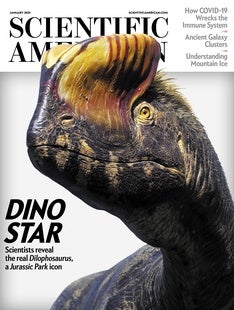Mars, once thought to be a static, dusty landscape, is ever changing. It wasn't until NASA's Mars Reconnaissance Orbiter (MRO) showed up that we observed shifting dunes, seasons coming and going, and dust devils swirling across the planet. The spacecraft recently marked its 15th anniversary in orbit around our neighboring world, where it has used a suite of four science instruments and three cameras to catalogue a diverse array of geologic features. “Before we had never had enough resolution over a long-enough period to see changes on the surface,” says Richard Zurek, MRO's project scientist at the Jet Propulsion Laboratory (JPL) in Pasadena, Calif. “Today we can see that Mars is dynamic.”
The orbiter, launched in 2005, has led to many discoveries about Mars's atmosphere, its surface and, thanks to radar, even what is buried underneath, via a cumulative 400 terabits of data beamed back to Earth over the years. It has also served as a communications satellite, relaying messages from the various landers and rovers that have visited the Martian ground during its stay. After 15 years the spacecraft is still in good health and has enough fuel to keep going for another 15 years at least—as long as its instruments hold out. “Of course, things could break unexpectedly, just like an old car,” says MRO deputy project scientist Leslie Tamppari of JPL. “But having that longevity can really deepen our understanding of Mars. There are things we can learn only by having a long baseline history of observations.”
The spacecraft's instruments have also exposed the beauty of Mars, revealing an alien world that bears surprising similarities to our own. Like many of the great photographs by the Hubble Space Telescope and other observatories, MRO's images aren't just science—they're art. Zurek recalls when Alfred McEwen, principal investigator of the High Resolution Imaging Science Experiment (HiRISE), came to visit JPL: “The secretary told him, ‘Go down the hallway, and when you come to the Impressionist painting, turn left.’ He went down the hall and saw that the Impressionist painting was actually a photo of Mars, taken by his camera.”
AVALANCHE: A cloud of debris hovers over a spot on Mars’s North Pole in this 2010 photo from the orbiter’s High Resolution Imaging Science Experiment (HiRISE). Most likely the aftermath of an avalanche, the scene shows a steep cliff made of layers of water ice topped with bright white carbon dioxide frost. Such vistas are common in this area every Martian spring, suggesting that the northern pole sees a recurring avalanche season when sunlight and heat break up the winter’s frost.
STRIPES AND WAVES: Varied and gorgeous textures blanket Mars’s dusty surface. Large dunes (top) undulate over the Nectaris Montes slopes within the Coprates Chasma canyon. Narrow troughs along the dunes in Russell Crater (middle) form when chunks of carbon dioxide ice slide down the steep faces of the dune. The dark channels seem to appear and rearrange with the seasons, creating different patterns each year the orbiter has photographed them. Lines of a different kind run down the slopes of a crater in the Arabia Terra region (bottom). These streaks form when dust cascades along the sides of the circular crater.
DUST DEVILS: A weather feature shared by Earth and Mars is the dust devil—a vertical column of dust spiraling upward around a pocket of lower air pressure. This one (top), captured by HiRISE in 2019, soars some 650 meters into the sky, as evidenced by the length of its shadow stretching off to the right. Dust devils carve meandering dark tracks (bottom) into the Martian surface when they pass over it by lifting away bright dust from the ground.
DUNES: Resembling wrinkled satin, dune crests rise from the Martian floor. Scientists study the shapes of dunes to understand Red Planet geology. Some curved peaks here, for instance, look like so-called barchan dunes, which form when the wind blows steadily in a single direction—a feature common in Earth deserts as well as those on Mars.



